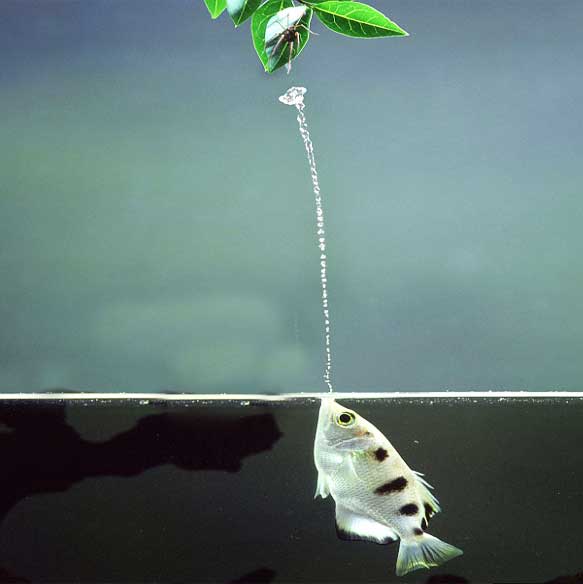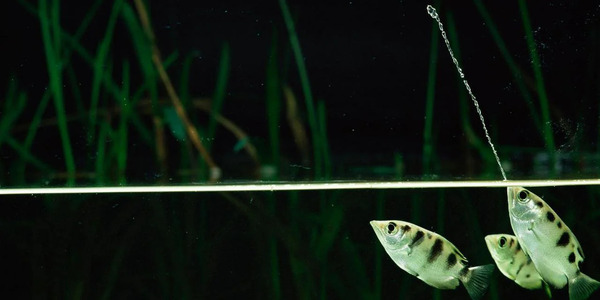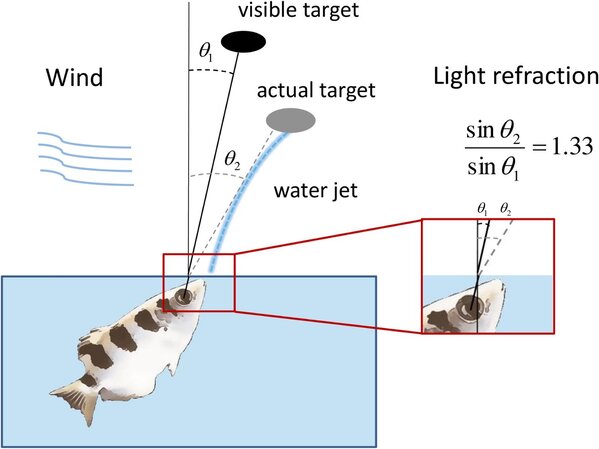The archerfish (genus Toxotes) is one of the most fascinating and unique fish in the world, famous for its incredible ability to shoot water with precision and force. This remarkable skill not only sets the archerfish apart from other aquatic creatures but also demonstrates the ingenuity of nature in adapting animals to their environments. In this article, we’ll dive into the world of the archerfish—its abilities, behaviors, and why it’s called the "marksman of the fish world."

Archerfish belong to the genus Toxotes, which is part of the family Toxotidae. This family is in the order Perciformes within the class Actinopterygii (ray-finned fish). The genus Toxotes includes several species of archerfish, all of which are renowned for their remarkable ability to shoot water at prey above the water's surface.
Archerfish have evolved a specialized hunting technique over millions of years. The ability to shoot water jets to capture prey above the water’s surface is thought to have developed as a result of the need to capture insects and small animals that live in or near water. This unique adaptation likely evolved in response to competition for food sources in their environments, helping them to exploit an ecological niche that other fish could not reach.
The first scientific descriptions of archerfish date back to the early 19th century. They were initially observed by European naturalists who were intrigued by their ability to accurately shoot water from their mouths to knock down prey. Their hunting ability was documented in various journals and articles, leading to further scientific studies and interest in their behavioral adaptations.
The name "archerfish" comes from the genus name Toxotes, which is derived from the Greek word "toxotēs" meaning "bowman" or "archer." This name is a reference to their ability to shoot a stream of water, similar to how an archer would use a bow to shoot arrows at a target. Their precision in aiming water jets at prey earned them this fitting name.
Archerfish are medium-sized fish, typically measuring between 10 to 30 cm (4 to 12 inches) in length. They have a streamlined body that allows them to swim quickly and efficiently through the water. The fish’s most notable feature is its elongated, tubular mouth, which it uses to shoot jets of water. Their eyes are large and positioned on top of the head, aiding in their precision targeting of prey above the water’s surface.
Their dorsal fin is located far back on their body, and their tail fin is well-developed for propulsion. Archerfish have a relatively simple, silver-colored body with a dark stripe running horizontally along the length of the body, providing them with camouflage in their natural environment.
Archerfish can be distinguished from other species in the Toxotidae family by their unique behavior of water shooting. While other fish in this family may share similar features, such as a tubular mouth and body structure, archerfish are the only ones known for their ability to shoot water with high accuracy.
The physical characteristics of their mouths also set them apart from related species. In comparison, other species of fish do not have the specialized mouth structure required to shoot water effectively.
Archerfish are generally considered intelligent and adaptive. They are known for their ability to learn and improve their water-shooting skills through experience. They exhibit social behavior and can sometimes be found in small groups, although they are not overly social creatures. They tend to be curious and explore their environment actively, often using their water-shooting ability for more than just hunting, including investigating their surroundings.
Archerfish are not known for long migrations, but they do exhibit some seasonal movement within their habitat. These fish tend to remain in shallow water near the shore, especially in areas with abundant prey such as insects. They do, however, move between different freshwater and brackish water zones, depending on seasonal changes and availability of food.
Archerfish are carnivorous and primarily feed on insects, spiders, and other small creatures that rest above the water’s surface. Using their highly specialized water-shooting behavior, they target and knock down prey, making it easier to capture and consume. They can adjust the angle and force of their water jets to hit small, elusive prey with impressive precision.
While archerfish are not aggressive toward other fish, they can exhibit defensive behaviors if threatened. They may use their water-shooting ability to scare off predators or rivals. This unique defense mechanism allows them to distract or disorient potential threats long enough to escape.
Archerfish are primarily found in Southeast Asia, northern Australia, and surrounding islands. They inhabit brackish and freshwater environments, including rivers, lakes, mangrove swamps, and coastal estuaries. Archerfish prefer shallow waters with abundant surface vegetation, as this is where they typically find their prey. They are distributed across a wide range of countries, including Thailand, Malaysia, Indonesia, and parts of India and northern Australia.
Archerfish spawn during the warmer months of the year, usually when the water temperatures are higher and the food supply is abundant. The exact timing of spawning can vary depending on local conditions, such as rainfall and temperature.
Archerfish are egg-laying fish. During the breeding season, males will court females by displaying territorial behaviors and performing mating rituals. After successful courtship, the female lays eggs in sheltered areas, often on submerged vegetation or in crevices. The male guards the eggs until they hatch.
Archerfish typically live between 5 and 10 years in the wild, although their lifespan can vary depending on environmental factors, food availability, and potential threats from predators. In captivity, with optimal care and conditions, some archerfish have been known to live longer.
Currently, archerfish are not classified as endangered, and there are no specific conservation laws in place that directly target the protection of this species. However, their habitats are threatened by human activities, such as deforestation, pollution, and habitat destruction due to urbanization and agricultural expansion.
The population of archerfish in the wild is generally stable, but localized declines have been observed in certain areas due to habitat degradation. Their natural habitats, such as mangroves and freshwater swamps, are under threat, which could potentially impact their numbers in the long term.
The main threats to archerfish include pollution, habitat loss, and climate change. Deforestation, industrial activities, and agricultural runoff are contributing to the destruction of the habitats they rely on. Additionally, overfishing in some areas can reduce their population.
There are no specific conservation efforts directed solely at archerfish, but protecting their habitats through broader environmental conservation initiatives can benefit the species. These include efforts to preserve wetlands, reduce pollution, and ensure sustainable management of water resources.
Archerfish do not have significant direct economic value, but they can contribute to ecotourism, especially in regions where they are featured in wildlife attractions. They also support local ecosystems by controlling insect populations, which benefits agriculture and human populations indirectly.
Archerfish are not commonly eaten, as they are not commercially fished for food. While they are technically edible, their small size and the difficulty of catching them in the wild make them less likely to be harvested for consumption.
Archerfish are of great interest to scientific research due to their unique behavior and high level of intelligence. Studies of their water-shooting abilities have provided insights into animal learning, precision targeting, and communication. They are also used in behavioral studies, particularly in research on problem-solving and adaptive learning.
Archerfish are remarkable animals, known for their unique water-shooting abilities and fascinating behaviors. Their specialized hunting techniques and intelligent behavior make them an extraordinary species in the animal kingdom. While not currently at risk, their habitats require protection to ensure their continued survival in the wild. From a scientific standpoint, they offer valuable insights into animal behavior, making them an important species for researchers.
Archerfish are best known for their water-shooting ability. These fish are able to expel a jet of water from their mouths, which they use to knock down prey (usually insects) that are above the water’s surface. The water stream can travel several feet and is incredibly accurate, allowing the fish to hit their target with amazing precision. Archerfish can even adjust the strength and direction of the water stream to suit their needs, much like a skilled marksman adjusting the aim of a weapon.
The process by which archerfish shoot water is a marvel of natural adaptation. Here's how it works:
Mouth Shape: The archerfish’s mouth is shaped like a tube, which allows them to shoot a focused jet of water. The fish gathers water in its mouth by creating a small pocket between its tongue and the roof of the mouth.
Water Pressure: When an archerfish is ready to shoot, it contracts the muscles around its mouth. This contraction creates pressure inside the mouth, forcing the water out in a powerful, directed stream.
Shooting Mechanics: The archerfish can control the strength of the stream and adjust its aim by changing the angle and force of the water jet. The fish shoots the water with remarkable accuracy, able to hit insects or other prey on branches or leaves above the water.
Targeting Prey: Archerfish often use this skill to hunt insects or small animals, which are usually perched on branches, leaves, or other objects above the water. By shooting water at their target, they knock the prey into the water, where it becomes easier to catch.
The primary reason archerfish shoot water is to capture prey. Their diet mainly consists of insects, spiders, and small invertebrates that live above the water. Archerfish have evolved this ability to help them catch prey that would otherwise be out of reach.
However, this behavior is not just for hunting. Archerfish may also use water shooting as a defense mechanism to deter predators or rivals. By creating a disturbance with the water, they might confuse or startle a potential threat, giving them a chance to escape.
Archerfish are capable of shooting water jets over impressive distances. Some species can shoot water up to 10 feet (3 meters), though the exact distance depends on the species and the individual fish. The accuracy and precision of the shot are also noteworthy, with archerfish able to hit a target as small as a tiny insect hanging from a leaf.
While archerfish are incredibly skilled at shooting water at prey above the surface, they cannot shoot at targets underwater. Their specialized mouth and shooting technique are designed specifically for reaching objects above the water, and they rely on sight to aim their shots. The behavior is most effective when the target is within sight and within reach of their water stream.
Archerfish rely heavily on their vision to locate their prey and aim their shots accurately. They have excellent eyesight, which allows them to spot insects and other small prey on branches and leaves above the water. The fish use their keen vision to gauge the distance to the target and adjust their aim before firing a water jet.
Interestingly, researchers have found that archerfish are capable of learning and improving their aim through trial and error. In laboratory settings, archerfish have been observed to adjust the strength and direction of their water jets, even after being exposed to new types of targets. This shows that their water-shooting ability is not purely instinctual but can also be influenced by learning and experience.

Abstract
Archer fishes (Toxotidae) bring down aerial prey by squirting water from their mouth. However, how they aim remains unclear. Previous studies have shown that the angle between the fish's body axis and the squirt (mouth angle) plays a role in aiming, but it has been suggested that more precise aiming could involve the lips and tongue. Our study challenges this idea. We found that the mouth angle is an individual characteristic and remains constant even across a wide range of target distances. Moreover, archer fishes do not have movable lips, and their tongue is too short to affect the direction of the squirt. Our findings suggest that aiming is primarily done by the fish's body, which rotates around the fixed eyeballs during aiming. Additionally, the eye angle at the moment of squirting is also an individual characteristic but is less consistent than the mouth angle. This variability is likely related to the refraction effect of light.
Introduction
Archer fishes can capture prey by squirting water from their mouths. suggested that Toxotes jaculatrix hits targets effectively despite the refraction of light by squirting nearly vertically and adjusting their aim after each failed attempt. However, this model doesn't apply to Toxotes chatareus, which can successfully shoot water at a wide range of angles (Dill, 1979). Previous studies, including ours, have shown that accuracy in squirting is a trait of the individual fish, with some even missing targets due to abnormal jaw growth. This study investigates how the fish aims its squirt, focusing on whether body posture, eye rotation, or mouth morphology contributes to aiming.
We previously found that the mouth angle (the angle between the fish's body axis and the squirt’s trajectory) plays a key role in aiming. Archer fishes are known to prefer squirting from further away when the target is high and closer when it is low, suggesting that the consistency of the mouth angle may be responsible. We aim to explore whether the fish’s body posture, particularly the body angle, influences the accuracy of squirting and how the eye angle might play a role in fine-tuning the aim.

Part I: Morphology of Lips and Tongue
To investigate whether the lips or tongue help fine-tune the squirt’s direction, we examined the anatomy of T. chatareus. Previous research suggested that the fish could use its lips or tongue to adjust its aim after positioning its body. However, our findings show that T. chatareus has no movable lips; instead, its jawbones are covered with skin. Additionally, the tongue is composed of connective tissue and is too short to reach the tip of the snout. These observations, supported by anatomical data, confirm that the lips and tongue are unlikely to play a role in directing the squirt.
Part II: Behavioral Study on Aiming Accuracy
The second part of the study focuses on the accuracy of the fish’s body positioning. Archer fish need to point their whole body to aim their mouth correctly. It has been widely observed that body positioning is crucial for accurate squirting (Dill, 1979). We filmed the fish while they squirted water at targets and measured the angles of the fish's body and mouth. Our data show that the mouth angle remains consistent across different target distances, suggesting that the fish uses body posture to adjust its aim, and the amount of fine-tuning needed depends on the target distance.
We also explored whether the fish uses visual cues to help aim its body. Archer fish have the ability to rotate their eyes (torsion) without moving their body, which is important for aiming at targets. This torsion has been noted in earlier studies and is a key feature of the fish’s visual behavior. As the fish approaches the target, it adjusts the position of its eyes and body to fine-tune the squirt.
Our study suggests that the primary mechanism for aiming in archer fish is the orientation of the body, not the lips or tongue. The mouth angle remains a key factor in squirting accuracy, but the body angle, controlled by visual feedback from eye rotation, plays an essential role. These findings provide a clearer understanding of the biomechanics of prey capture in archer fish and challenge the hypothesis that lips or tongue are used for fine-tuning aim.
Archerfish are native to Southeast Asia, Northern Australia, and some surrounding islands. They inhabit a variety of aquatic environments, including mangrove swamps, coastal areas, and rivers with brackish or freshwater. They tend to live in shallow waters, where they can easily spot and shoot at prey above the surface.
Social Fish: Archerfish are often found in small groups, and they sometimes work together to hunt larger prey or deter predators. They have also been observed using their water-shooting ability in social contexts, such as when competing for food or space.
Intelligence: Archerfish are known for their problem-solving abilities. Researchers have trained them to shoot at specific targets or respond to different cues, demonstrating their intelligence and adaptability.
Not Just for Hunting: In addition to using water jets to catch prey, some archerfish have been observed using their water-shooting ability in playful behavior or to explore their environment.
The archerfish is a fascinating example of how animals can evolve specialized behaviors to thrive in their environments. Their ability to shoot water with precision is a remarkable adaptation that helps them catch prey, protect themselves, and navigate their surroundings. As one of the most skilled "marksmen" in the animal kingdom, the archerfish’s unique water-shooting behavior continues to captivate researchers and animal enthusiasts alike. Whether for hunting, defense, or even play, the archerfish showcases the ingenuity of nature’s designs.
animal tags: archerfish genus-Toxotes
We created this article in conjunction with AI technology, then made sure it was fact-checked and edited by a Animals Top editor.